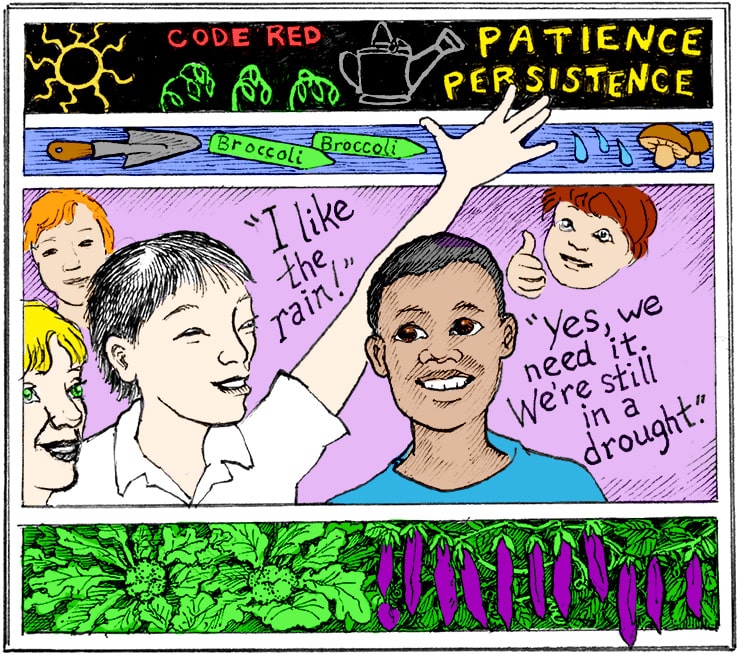Read by Matilda Longbottom
I really don’t think I should be the person teaching young children to garden.”
These were the words I said when I was asked to serve as the Garden Leader at the Georgia elementary school where I teach. In past years, a skilled Master Gardener had told the students exactly when and how to tend the lovely vegetation that graced the children’s raised beds. But that Fall our Master Gardener would not be returning. That left me, a person who’s killed more plants than she’s cultivated, to lead the next generation of gardeners. For the sake of everyone, I said no, which led to a couple of my colleagues talking me into taking the job anyway. (I’m one of those teachers who has a heart as mushy as a compost pile when it comes to helping kids.)
I’ll admit, there was something else that enticed me. Every Fall and Spring the garden club has a harvest party where the students sample the produce they’ve grown. I’d witnessed kids devouring succulent peas, tender carrots, and crisp lettuce, and my mouth watered as I imagined the Fall produce we’d harvest.
At the beginning of the school year there was a bit of a drought, but optimist that I am, I believed the rain would come and we’d enjoy a bounty from our school garden patch. But as Summer turned into Fall, the drought worsened. We ran out of water in our rain barrels, which sat dry for more than a month. The students tried to help by lugging watering cans back and forth from a nearby spigot.
Then everything that could go wrong, did go wrong. After two plantings, we dug up what I can only describe as radish twigs instead of radish bulbs. I could go into all the similarly depressing details about the spinach and the carrots, but the bottom line is this: they didn’t make it.

A local gardener donated an abundance of broccoli plants. We filled some boxes inside the garden fence and planted what was left outside the fence. Imagine our horror when we found that something had ripped the outer plants from the ground. We decided the culprit was a deer, scavenging so close to the school because of the drought. I didn’t have a lot of hope for the broccoli left inside the fence: each day seemed drier than the one before.
Meanwhile, wildfires raged through north Georgia. I teach in the suburbs of Atlanta, and we had Code Red days, which meant students couldn’t go outside for garden club because of the air quality. Reality set in. There would be no Fall harvest party.
Finally, rain did come, late in November, on the last day of garden club. We had planned a beautification project for the school grounds, but the rain became torrential. Twenty-six disappointed students had to trade an outdoor service project for an indoor lesson on fungus.
Dispirited, I wondered how we could count our semester of gardening as a success in any way.
Just then a fifth-grade boy piped up, “I like the rain!” Another boy added, “Yes, we need it. We’re still in a drought.” I felt sheepish—I’d been so focused on our little garden I hadn’t thought about how the drought wasn’t over yet. The children talked more about the drought, which led to a discussion about farmers and how, when it came to weather, they had to take what they got. We all agreed that we had a new respect for them.
There was one thing I didn’t hear, however—complaining. When I thought about it, I hadn’t heard the students gripe any that semester, even when they worked to no avail in the garden. Instead of reaping broccoli and carrots, they’d reaped patience and persistence. They were trying their best, and so was I, flawed garden leader that I was.
Honestly, I don’t think the students even noticed that we didn’t harvest any produce. They’d been content to dig, pluck, water, shovel, and discover interesting bugs. Their focus was on being in the garden with their friends— in the dirt and in the moment. It doesn’t take a garden genius to teach children that.
So in the end, it was the teacher who got schooled. The following semester, I opened the garden gate and was surprised to see that the broccoli we planted in the Fall had flourished, burgeoning with healthy florets, and the peas that I thought had succumbed to the dry Fall days had overwintered. When it came time for the Spring harvest party, the pea pods were so plentiful they nearly pulled the vines to the ground. We had a fine harvest.
But I’d learned by then that wasn’t what was most important. ❖


 Previous
Previous

